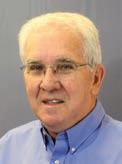RESOURCE
EQUIPPING CHURCH LEADERS EVENTS & SERVICES
SEPTEMBER – DECEMBER
LEADING THE VOLUNTEER
ARMY

Improve recruiting
6 types of influence
FALL 2019
ILLINOIS BAPTIST STATE ASSOCIATION
Special section Abuse prevention
P.16
+
Outreach ideas you can use now






Mission Illinois Offering & Week of Prayer Sept. 8-15 missionillinois.org
INSIDE
2 Eric Reed XXXXXXX XXXXXXX
FALL 2019

6 Carmen Halsey Help young people lead from their strengths
7 Jack Lucas
ILLINOIS BAPTIST STATE ASSOCIATION

EDITOR
Eric Reed
DESIGNER
Kris Kell
COMMUNICATIONS DIRECTOR
Lisa Misner
8 Steve Hamrick
9 Pat Pajak
EDITORIAL CONTRIBUTORS
Meredith Flynn
Leah Honnen
Published three times each year, Resource provides new information about IBSA ministries, equipping opportunities, and services. This periodical is sent free of charge to church leaders. To request more copies for your leaders, contact Communications@IBSA.org. Resource is also available online at http://resource. IBSA.org.
For questions about subscriptions, articles, or events contact the IBSA Communications team at (217) 391-3119 or e-mail: Communications@IBSA.org.
POSTMASTER: Resource is owned and published 3 times each year (Jan., May, and Sept.) by the Illinois Baptist State Association, 3085 Stevenson Drive, Springfield, Illinois 62703-4440.
IBSA.org 01 10 ENG AGE MORE WORKERS Jeff Gonzalez identifies 5 recruiting barriers 13 FOCUS ON TEACHING This acronym makes biblical principles clearer 14 ‘FRACTALS’ Interactive: Multiply your pool of ministry workers 15 J ACK SPARROW’S LEADERSHIP S TYLE Bryan Price says it starts with influence 17 NOT A SOLO SPORT It’s true. There’s no “I” in team, according to Doug Munton 18 SPECIAL REPORT Abuse Prevention Includes: Signs of “grooming” and a checklist for your church INSIGHT
school
What does your local
need?
Tis
for welcoming guests
the season
Stick the landing in 2019 PLANNER 23 Monthly calendars September through December 26 Interactive: Fall outreach ideas It’s punkin chunkin’ time Plus: 3 Wise Guides 23 Prepare for back-to-school EQUIPPING 29 IBSA Annual Meeting 30 Leadership development 31 Missions opportunities Volunteers You can’t draft ‘em so how can you lead ‘em?
LEADER LIFE Pep rally
“Will they revive the stones…?”
“It’s amazing how quickly human beings— and churches—lose their sense of purpose and vision,” Rick Warren writes. “Vision casting is not a task you do once and then forget about. You must continually clarify and communicate the vision of your church. This is the number one responsibility of leadership.”
Warren said leaders should communicate the vision of the church every 30 days. He points to an Old Testament example: When the Hebrews returning to Jerusalem were rebuilding the wall, they got discouraged about halfway through the 52-day process. The prophet exhorted them to redouble their efforts to finish the job.
Keeping people committed to what may be a long process is not easy. Read Neh. 4 and discuss with the team:
1. Why do workers get discouraged, both in Nehemiah’s time and in our own?
2. What is the advantage of pairing the team members? How can we use that tactic?
3. What is the significance of encouraging and regrouping at the halfway point?
Xxxxxxxxxx
Revitalizing leaders tell the old, old story
With all the talk today of revitalization, the big question becomes How? And if we deduce the answer to that one, how do we bring others onboard?
Here are some ideas from an ancient prophet, Walt Disney. In the decades after Disney’s death, his team members expanded his kingdom based on his creative ethos. For more than 50 years, they have succeeded in keeping a herd of creative cats moving in one cohesive direction.
A Disney-coined phrase combines imagination with engineering. Leaders might also use these recommendations for “imagineering” as we develop and communicate the vision.
Imagineering VP Mickey Steinberg offered Mickey’s Ten Commandments to his team. For church leaders, start with the sanctified imagination of the Holy Spirit to develop and promote engaging and effective plans for ministry.
1. Know your audience
2. Wear your guest’s shoes. Don’t forget the human factors, see it from their point of view.
3. Organize the flow of people and ideas. Ensure experiences tell a story that is organized and logically laid out.
4. Create a “weenie.” This was Walt Disney’s term for a “visual magnet,” something that catches both the eye and
the imagination.
5. Communicate with visual literacy. Use a dominant color or shape or building to reinforce a theme.
6. Avoid overload. Do not offer too much detailed information.
7. Tell one story at a time. Put one “big idea” in each show.
8. Avoid irrelevant or contradicting elements. Make sure the audience has a clear idea of what is being said.
02 RESOURCE FALL 2019
Read Nehemiah 4














DIRECTORY IBSA IBSA.org 03
Nate Adams Executive Director (217) 391-3108
Cooperation Team Jeff Deasy Associate Executive Director (217) 391-3104 Carole Doom Information Specialist (217) 391-3113 Drew Heironimus Director Information Systems (217) 391-3112 Kendra Jackson Bookkeeper (217) 391-3111 Ashley Parsons Accountant (217) 391-3106
Communication Team Eric Reed Associate Executive Director; Editor, Illinois Baptist (217) 391-3109 Leah Honnen Administrative Assistant (217) 391-3127 Kris Kell Graphic Artist (217) 391-3115 Lisa Misner Director Communications (217) 391-3119 Evangelism Team Pat Pajak Associate Executive Director Zone Consultant – 3 (217) 391-3129 Linda Darden Ministry Assistant (217) 391-3137 Meredith Flynn Managing Editor Illinois Baptist (217) 391-3120 Barb Troeger Executive Administrative Assistant (217) 391-3107
Executive Team
Church
Church
Church Resources Team
(217) 391-3136
Men’s Ministry and Missions Mobilization (217) 391-3134
Lake Sallateeska Baptist Camp (618) 336-5272
Women’s Ministry and Church Missions (217) 391-3143

(217) 391-3132
(217) 391-3135
(815) 672-0084
391-3124
Zone Consultants
(217) 391-3128
(847) 754-0356
901-2767
Bob Evaul Zone 7 (618) 567-6170

Larry Rhodes Zone 8 (618) 972-5683










Ben Jones Zone 9 (618) 308-7600

Stephen Williams Zone 10 (618) 920-8545






04 RESOURCE FALL 2019
DIRECTORY
Mark Emerson Associate Executive Director Zone Consultant - 1
Dwayne Doyle Director
Philip Hall Manager
Carmen Halsey Director
Steve Hamrick Director Worship and Technology
Jack Lucas Director Student/Next Gen Ministries
Mike Young Manager Streator Baptist Camp
Tammy Butler Ministry Assistant (217)
Debbie Muller Ministry Assistant (217) 391-3126
Tammy Ratsch Ministry Assistant
Joe Oliver Zone 2
Brian McWethy Zone 4 (815)
Joe Gardner Zone 5 (309) 369-1403
Cliff Woodman Zone 6 (618) 946-5720
Aubrey Krol Ministry Assistant (217) 391-3138
Church Planting Team
751-0695
(814) 221-4173
710-3106
E-mail IBSA Staff Type the first and last name (no spaces) @IBSA.org.

Local Associations
ANTIOCH (270) 816-5236
BAY CREEK (217) 779-7477
697-1036
608-0349
IBSA Zones 1-10
Example: LisaMisner@IBSA.org 1 2 3


BIG SALINE (618) 252-1415
CENTRAL (217) 330-7593
CHICAGO METRO (773) 278-4400
CLEAR CREEK (618) 833-4481
EAST CENTRAL (217) 586-5599
FOX VALLEY (573) 579-8143
FRANKLIN (618) 439-3742



GATEWAY (618) 254-3953
GOSHEN TRAIL (618) 643-2937
GREATER WABASH (618) 847-3041
HEARTLAND NETWORK (217) 529-3429

KASKASKIA (618) 227-0001

LAKE COUNTY (847) 336-3960
LOUISVILLE (618) 283-0842
MACOUPIN (217) 854-8279
METRO EAST (618) 624-4444
METRO PEORIA (309) 633-5440
NINE MILE (618) 357-5171
NORTH CENTRAL (815) 633-6323
OLNEY (618) 392-7001
PALESTINE (618) 569-3189
QUAD CITIES (309) 221-4143
REHOBOTH (618) 283-0842
SALEM SOUTH (618) 242-7862
SALINE (618) 252-1440
SANDY CREEK (217) 882-2231
SINNISSIPPI (815) 440-2894
THREE RIVERS (815) 725-7361
UNION (618) 524-9738
WEST CENTRAL (309) 351-5499
WESTFIELD (217) 895-5214
WILLIAMSON (618) 993-6069
4 5 6 7 8 9 10
IBSA.org 05 DIRECTORY
Tim Bailey Suburban Church Planting Catalyst Northeast Region
Jorge Melendez Strategist Fox Valley, Lake County (630)
Eddie Pullen Church Planting Director (618)
Ken Wilson Catalyst Central & Southern Regions (618)
John Yi 2nd Gen. Church Planting Catalyst Northeast Region (312)
Rachel Carter Ministry Assistant (217) 391-3101
Play to your strengths
It’s a big question, maybe the biggest, in church and ministry leadership: How do we reach and develop the next generation? How do we bring younger men and women to the table, help them see their leadership potential, and release them to do the things God is leading them to do?
Our answers will vary according to our church and ministry contexts, and they may involve a variety of systems and processes. But I think a good first step for anyone trying to develop young leaders is to decide you’re going to create environments where they can ask questions, struggle with the answers, and ultimately thrive. In other words, decide you’re going to intentionally disciple young leaders.
Here’s good news for my generation: We are uniquely positioned to do this, and to do it well.
No matter how old you are, the next generation is looking to yours for encouragement and affirmation that they are indeed effective leaders—or can be. They come equipped with energy and courage to face difficult things in the culture, but they want someone to listen and guide them as they work through the hard things in their personal lives.
I’ve seen this principle at work in a multi-generational discipleship group that meets every week at my house. The younger women want to know that the things they’re living through now can be used by God—and have been used well in other people’s lives. There’s something about hearing older women reflect on their own seasons of life that brings hope to younger women.
During my years in healthcare, I learned how the body is created to heal itself. As a nurse, I couldn’t heal a wound in my own power. But I could apply a dressing, thereby making an environment conducive for the body to do what it was created to do.
The same principle applies here: God is the author of all life transformation. He inspires leaders and potential leaders to do the good works he has created for them to do. But we can partner with him in building environments that ease the process.
The young women leading across Illinois aren’t afraid to take a strong stand, but they need (and want) help. We don’t have to have all the answers or the resources, but we can come alongside them with intentionality. We can listen and, most importantly, speak God’s Word into their lives. We can decide to pass the baton.
CARMEN HALSEY is IBSA’s director of women’s ministry and church missions. CarmenHalsey@IBSA.org

06 RESOURCE FALL 2019
How one generation can help the next
INSIGHT LEADERSHIP
Think outside the backpack
Add heft to outreach to schools

School season is upon us, offering our churches great opportunity to serve the schools in our communities. As we brainstorm ministry opportunities for this fall, let’s ask leaders and volunteers these questions: What can we offer teachers and school administrators in the way of resources and encouragement?

How can we position our church as a go-to resource for families in need of support?
Much of our school year ministry centers on meeting physical needs. School supplies, free haircuts, new tennis shoes—all these giveaways and donations are wonderful ways to help families in this busy, often expensive season. But ministry opportunity doesn’t end when kids have returned to their classrooms. Consider adding one or more of these longer-term strategies to engage with schools and families:
Try to meet unique needs. One school in our community required each student to stock the office by bringing a ream of copy paper at the beginning of the school year. We asked the school what they needed most. Paper, the staff said, so our church provided enough paper for the year, so that families didn’t have to.
Share your space. Another of our local schools had space issues in their gym. We opened our church gym so their teams could practice there, and also hosted the school’s sports banquets in our fellowship hall. Families visited our church who first heard about us after their child met us through school sports.
Work with administrators. You may be surprised at how willing your local principal is to partner with your church. Even with the caution required to keep church and state separate, school administrators often understand that churches want to help, with no other agenda in mind. Our church was blessed to build relationships with principals who later sent families our way when they had specific needs.
Don’t forget older kids. For teens in the community, plan an end-of-summer or back-to-school bash. When our church hosted this high-energy outreach, students came to reconnect with their friends and our church, and they left with a calendar of events we’d planned for the year ahead.
Expect a cumulative effect. The best way to sum up back-to-school outreach is that it often moves the needle little by little as our churches build relationships with teachers, administrators, and families. The impact we make will likely share a close correlation with how consistent and sacrificial our ministry is, and how prepared we are to interact with the families who do show up at church.
Our church had the opportunity to minister to couples and families that we never would have had if we hadn’t provided school supplies for their children, or hosted basketball practice for their teams. As you think about school season, gear up for long-term ministry that really helps families.
JackLucas@IBSA.org
IBSA.org 07
INSIGHT LEADERSHIP
DEVELOPMENT
JACK LUCAS is IBSA’s director of next generation ministries.
Effective holiday events
Are seasonal programs worth it?
Every year about this time, music leaders are asking the question, what can I do for Christmas? Some churches have long traditions of presenting musicals, Christmas Eve services, children’s programs, or special seasonal events. Remember the live nativity and the singing Christmas tree? Should a church bother with special productions these days?
Before deciding, consider who you are trying to reach. Is the event going to be a worship service for the church? Or is it going to be an entry point for the unchurched? This decision answers the “why should we” question. Special events can still reach people, but churches need to be much more intentional. The “y’all come to the cantata” approach is not very effective today. If the event is intended for the unchurched, here are some suggestions:
1. Make the program friendly for non-church goers. This doesn’t mean to schedule a lot of secular Christmas songs, but think through the program from a guest’s perspective. Avoid using churchy words or phrases. Make sure the gospel message is clear.
2. Plan an early date. Is Sunday morning the best time, or would an unchurched person more likely attend on Saturday night or a weeknight? Sometimes early December will be better, prior to all the school and community Christmas activities. Check with the local schools and try not to do it on their concert nights. Better yet, invite the band or chorus to present their seasonal concert at your church as an additional presentation.
3. Involve many volunteers in the production. Why? Each volunteer has family and friends who will attend. If you include a children’s choir, their parents and grandparents be there for sure.
4. Present a quality program. But keep in mind what your church can deliver on a weekly basis. You don’t want to give your guests the impression of bait and switch. I suggest put your best planning energy in the weekly worship services. This will also affect and improve how well you can then put together a special program.
5. Design, print, and give away tickets. A professionally printed ticket will include details about the program. The tickets can be placed on the guest’s refrigerator and serve as a daily reminder about the upcoming program. Also, tickets give the impression to the attendee that the program will be well done. Convince church members to give tickets to unchurched friends and neighbors. Encourage members to take their guests out to dinner before or after the presentation.
6. Register everyone in attendance. Ask for name, address, email, and phone. Consider a giveaway for those who complete their registration if that fits your ministry.
7. Plan for follow-up. I’ve seen too many churches put on a great presentation, have unchurched people attend, and then do nothing afterward to reach them. Enlist an outreach team to contact and follow-up. Take it on the road. While it may not involve your entire production, you can present the program at the town square, mall, union hall, hospital, or retirement home. I personally recommend scheduling these outside events prior to the church performance as some guests will want to hear it again. This also serves as a great dress rehearsal or extra practice before the larger event.
STEVE HAMRICK is IBSA’s director of worship and technology. SteveHamrick@IBSA.org

08 RESOURCE FALL 2019
INSIGHT OUTREACH
Year-end checklist
It doesn’t really matter how well a person starts the race, the winner is always determined by how well he finishes.
The Bible declares this about Saul, the first King of Israel. He was tall and handsome, just what the people wanted when they begged Yahweh to give them a king. But a few chapters after his appointment, Scripture reveals Saul’s unlawful sacrifice, his sparing of the Amalekites against God’s instructions, jealousy over David’s victory, his attempted murder of David, his murder of the priests of the Lord, his incessant pursuit of David’s men, his consultation with a medium, and ultimately his tragic death. “The Lord regretted that He had made Saul King over Israel” (1 Samuel 15:35).
On the other hand, there are dozens of biblical people who obediently followed the Lord, often through difficult circumstances. Joseph, Moses, Joshua, Gideon, Ruth, David, Elijah, Peter, Paul, and others finished well. That should be our aim in ministry, and even now as the end of the year approaches.
Fall seems to be a time when many churches begin to wind down for the year. Instead of a slump, plan for a jump. It’s a great time of the year to invite new people to worship and to plan fall activities, closing out the year with measurable victories.
Use the fall to train church members how to share the gospel. Encourage each one to reach one. Celebrate baptisms, start a new Bible Study Class, introduce a sermon series that will prepare members for Thanksgiving and Christmas. Take on a fall mission project in your community.
Fall is a great time for a high attendance day, inviting friends, neighbors, and relatives. Plan a boxed chicken dinner following the morning service, and give away a coffee cup or tumbler with the church name on it to every first-time guest.
Plan a bonfire, hayride, and hot dog cook out. Organize games for the kids. Ask someone to share a brief testimony. You might interest people who never responded to a church invitation before to attend an outdoor activity.
Consider having a movie night with free popcorn and sodas. Encourage members to invite their friends. Bring lawn chairs and blankets. All you need is a laptop, projector, and side of a building as your screen. Have an intermission and share the gospel. Perhaps show “The Passion of the Christ,” “War Room,” or other Christian movie.
Begin collecting food items on a weekly basis. Ask a local grocery store if you can have a few carts and place them at the doors. Prepare a list of non-perishable food items that church members can bring each week. In November, box up Thanksgiving baskets as a mission project.
Sponsor a health fair. Ask health care workers in the congregation to check vital signs, or invite the local pharmacy to offer flu shots. Plan a couple of brief health care classes and repeat them several times. Have church members in attendance to share the gospel. Then, thank the care team and pray over health care workers in the next Sunday morning service.
It’s time to try something new. Instead of winding down to a long holiday break, wind up to the year’s end with outreach and baptisms, and finish well!
PAT PAJAK is IBSA's director of evangelism. PatPajak@IBSA.org

INSIGHT MEN’S MINISTRY
As 2019 reaches its conclusion,there’s lots to do to finish well.
IBSA.org 09
ENGAGING MORE WORKERS
 by JEFF GONZALEZ
by JEFF GONZALEZ
Every church could use more workers. A ministry leader is always in need of them, but sometimes good volunteers can be hard to find. We may sometimes blame the commitment level of our congregation. We ask ourselves, “Why don’t more people step up and serve?” But a better question is “What’s preventing people in our church from engaging in service?”
The Unstuck Group conducted a survey on volunteerism in the church. They reported 46% of adults and students serve in their church at least once per month. At the high end of the report churches reported 70% engagement, and lowest reported was 20% engagement.
Rather than bemoan the lack of volunteers, many churches could benefit from this simple exercise: identify the barriers to service, and do something about them.
LEADERSHIP
10 RESOURCE FALL 2019
Here are five barriers that may be hampering your recruiting
Barrier 1: Nobody’s tracking them
Serving is one area of spiritual growth the church should track. How many people are serving in in our church’s ministries on a monthly and quarterly basis? If we don’t track them, it is hard to know if the church is making progress, or if the members themselves are growing. Serving is not about doing a task but growing in our spiritual walk with Christ.
[Are you helping more people from your church grow in the walk with Christ by the evidence of their level of serving?]
Jesus said, “Even the Son of Man came not to be served but to serve others and to give his life as a ransom for many” (Mark 10:43). Jesus modeled for us what he expects for growing believers. We are never more like Jesus than when we are serving others. The church helps believers grow in Christ-likeness when we intentionally give them opportunities to serve.
Barrier 2: Too many ministries
There are times when our church tries to do too many ministries. A church that has an above average percentage of volunteers may still struggle with having enough volunteers. If this is the case, the problem is probably having too many ministry programs all competing for volunteers.
Example: First Church desperately needs workers for their children’s ministry on Sunday mornings, while at the same time they have a large and dedicated group of volunteers for the kids’ club on Wednesday night. Everyone is excited about the Wednesday night kids ministry, without realizing it’s costing them in effective, ministry that will better reach families and ultimately produce church members. Churched kids come to the weeknight event, but new families with children are still more likely to attend on Sunday. The answer to this dilemma is simple, but it won’t be easy.
[The hard decision is which programs to cancel, in order to staff those that will reach guests and grow disciples.]
The more programs our church offers, the more opportunities we provide people to attend ministries, events, and programs. That sounds like a good thing, but all those programs mean fewer workers for mission-critical ministries, and, for people who attend an overabundance of programs, there’s less time to volunteer themselves.
Barrier 3: Lack of leadership
In some cases, the lack of workers can be attributed to a lack of leadership. Consider three symptoms of a leadership “lid” the church may be experiencing. There’s no one serving as champion over volunteer engagement. Does our church have anyone overseeing the volunteer process?
Many churches don’t have even one person responsible for the process of engagement, so every ministry area is doing it themselves. Men, women, and children’s ministries, missions and worship teams are all fishing in the same pond. As a result, ministry leaders bump into each other in their competition for new workers, and some incoming people who would be willing to serve get lost in the shuffle.
Example: Emily volunteers in the children’s ministry. All goes well at first, but within a few months, this ojnce-enthusiastic worker realizes that kids’ ministry is not for her. Soon Emily drops out of the children’s department. Because no one is championing engagement, she doesn’t get help finding another volunteer opportunity. Emily doesn’t know who to go to, so she goes back to the pew. Or she goes home.
The staff is over-worked. The paid staff spends too much time doing ministry itself, instead of equipping volunteers to lead and operate those ministries. Ephesians 4:12 applies to associate pastors and senior pastors alike. Their purpose is “to equip the saints for the work of ministry, for building up the body of Christ…”
Leaders have an inadequate span of care. In other words, there are too few leaders trying to lead too many people. The result is that volunteers who need care don’t receive it, because the person responsible for their care is stgretched too thin to notice the need or provide the care.
IBSA.org 11 Continued on p. 12
This may be true of both paid staff and volunteers. Teams may grow large because of effective leadership, but they won’t stay large or successful if the responsibility for care isn’t divided as the team grows. This reality is hard for some leaders to see. They think they can do it all themselves, but everyone has limits.
Remember the biblical example of Moses’ father-inlaw. When Moses was overworked caring for the people, Jethro advised him to share the responsibility by assigning oversight of groups of 1,000, 100, 50, and 10 Israelites. The leader who is exhausted or ineffective should know the shared-leadership principle still works today.
When volunteers begin drifting away, it may be because they feel uncared for, whether they know it or not.
Barrier 4: Too complicated to join a team.
Churches are notorious for making the process to join a team confusing. Or at the least, they don’t provide the next intentional step to joining. Does our church have an on-boarding process that helps people who are interested in serving join a team? That is the first step to removing the barrier: make it simple and clear on how to join a team. And then develop a follow-up plan to help new volunteers get plugged in, trained, and serving.
Barrier 5: Vision gap.
Do our church members know the “why” behind serving? People need to hear it from the Bible and from the pulpit.
[Does the lead pastor communicate a compelling vision that includes the significance in serving?]

The congregation needs to see how their investment of their discretionary time will help make kingdom impact in their church and community. To do so, they will need regular teaching that draws the connection of believers’ service to fulfillment of the church’s mission—specifically the Great Commission and to their own discipleship. And they will be encouraged by a regular stream of success stories from their church’s ministries. Everyone wants to know their time is well invested, and that their service is making an eternal difference in the lives of others.
The greatest challenge yet
More than ten million people volunteer in only seven organizations: Special Olympics, Salvation Army, YMCA, Habitat for Humanity, United Way, American Red Cross, Big Brothers/Big Sisters. And yet there are hundreds of volunteer organizations. The reason those few organizations have the lion’s share of volunteers is because they offer a compelling vision. They move the hearts of people to serve.
The church has the greatest message ever told and the greatest mission to humanity. The church needs to do a better job communicating the vision so volunteers can understand their impact when God uses them to change a life for the kingdom.
[If the church is able to cast a compelling vision of the incredible opportunity God gives his followers to make an eternal difference in the life of another person, then more people will volunteer to serve.]
God gave the church his own mission to go out and reach lost people with the gospel, baptizing them, teaching them, and sending them out as disciples. God gives us the opportunity to be part of his kingdom purpose.
What is great about this mandate is that God gives each of us special gifts to accomplish it. He describes his people with these unique gifts as part of the body. He hasn’t called all of us to be the head or the arm. Instead he illustrates how the parts working together as a body can accomplish incredible things, but every member must bring his own unique gifts to the enterprise.
Remember, it’s not the lack of volunteers that keeps a church from being effective in ministry. It’s the barriers that keep would-be volunteers on the bench rather than in the work. When we present service as a spiritual growth opportunity, instead of a survival tactic for the church, we will see people step up. When we are engaging more volunteers, then we will know that people are growing in their walk with Christ.
VOLUNTEERS 12 RESOURCE FALL 2019 R
Jeff Gonzalez is an experienced leader in business and ministry. He is a consultant with IBSA in the area of church health and growth.
FOCUS sharpens application Preach, teach, repeat
We live in a culture that is post-Christian and biblically illiterate,” Jeremy Byrd said at the Illinois Leadership Summit. “Scripture is like a map. It shows us where God is. It shows us where we are. It shows us step-by-step how we make our way to God, but many people have not been taught how to read this map.”
Byrd advocates exposition of a single passage of Scripture in several sessions during the week. As pastor of Lincoln Avenue Baptist Church in Jacksonville, Byrd offers a pastor’s class each Wednesday night, where congregants can ask questions and dig into the Scripture from his Sunday morning sermon in a small group setting.
“I take ser mon notes and type up a manuscript, then teach that on Wednesday nights,” Byrd said. “Instead of preparing two separate studies for the sermon on Sunday and our core class on Wednesday nights, I am able to dig deep with our members and have a format for them to ask questions that rose from Sunday’s sermon.”
Byrd’s method, which he details on his blog “Textploration,” is called the FOCUS method. It is a two-step process, preaching from a text that will also be used as the listener’s personal Bible study. Byrd has five goals.
Byrd has used this FOCUS strategy to lead weekly men’s groups and disciple others one-on-one. His goal is to teach people how to approach the Bible so that they establish habits that enable them to read and understand for themselves.
Will Musgrove attends the men’s group. “There are no shortcuts here! In a Twitter and TV age, it’s easy to drift into a shallow pattern of skimming over the Bible,” he said. “Like any discipline—which the Bible says may seem unpleasant for a time—following the FOCUS method yields a harvest: I slow down, avoid mental shortcuts, and take the time to consider all aspects of the text to hear God speak in new ways.”
With his method of preaching and teaching smaller bites in of the Bible in multiple sessions, Byrd said “more of the word is sinking into people. It’s taking less time for you to prepare, and the pastor is more able to serve others rather than burning out by doing everything three times.”
O U
FFamiliarize contextually. Byrd aims to have everyone in his groups begin with the same base of information, including the historical context of the passage, literary context, and grammatical context.

Orient theologically. Explain what the passage says about God and what these verses reveal about creation or the fall. Then Byrd asks, How does this apply to the audience as a whole, and the person individually?
CChallenge applicably. A pastor needs to ask his congregation to check themselves. Where are they today in their walk with Christ? What steps from this sermon could help them on their way? And what is the pastor’s end point—that one thing he wants people to remember? It doesn’t matter who you are, Byrd said, the Bible is going to speak to you personally. “One of the things they taught us in seminary, you can’t feel your way to God. He’s revealed the path to himself.”
Undertake incrementally. Byrd regularly explains one way for each person to step forward in his or her journey with Christ. Perhaps the listener is ready to invite Christ into his life. Maybe he has questions to be answered. Another person could be ready to join the church or may need to plug into a small group setting to grow more in the faith. Every person needs to have identified a small step to that week, perhaps even that day in the church service.
SSummarize personally. Here the listener takes ownership. Each person has opportunity to follow through on the message and share his faith journey with others.
LeahHonnen@IBSA.org

IBSA.org 13
LEAH HONNEN is administrative assistant for IBSA’s Church Communications Team.
INTERACTIVE SHARING THE LOAD WITH FRACTALS
Few projects collapse at the point of dreaming or planning. It’s not until the execution stage that the wheels fall off. One way to keep rolling is to divide the project into pieces and assign the parts to various teams and people.
These fractal squares will help you share the load. (A fractal is a geometric pattern that can be repeated endlessly, in this case, squares within squares, within squares.)
A pastor in Hawaii who popularized the “fractals” system instructed members of his teams to divine their jobs into four pieces, take one piece for themselves, then recruit three people to take responsibility for their other pieces. And then do it again, and again. The volunteer force of the church grew exponentially.
Here’s how it works.
1 2 3 4
1. Choose a project or ministr y in development in your church. Perhaps you have a new discipleship group starting in the fall, or an evangelistic outreach, or a mission project. Or you may have a ministry that needs additional leadership.
2. Think how the project may be divided into four parts. Write that inside the blocks.
3. Identify and recruit leader-workers. When each square is filled with a goal or area of responsibility, write in the name of a person who can lead or accomplish each component part. These leaders may
have insight into the capabilities of various church members who can join the team, as the four blocks are divided again.
4. Share the “fractals” concept with leaders on every level. Copy this form and use it for a variety of projects. Sharing authority to pick their team will improve motivation and accountability.
If volunteer workers learn to divide the work from the beginning and share the responsibility with others, they will grow the ministry and its leaders all along the way.
–
14 RESOURCE FALL 2019
Eric Reed
What kind of influence are you? Deck copy
by BRYAN PRICE
In the golden age of piracy, a pirate captain had power, authority, and a wide-brimmed hat that set him apart as commander of his ship. His crew agreed to follow their captain wherever the seas took them.
While the captain had legitimate power to move the ship onward, the ship’s quartermaster had a different kind of influence. Often placed second in command, the quartermaster’s primary job was to take care of both the needs and the discipline of the crew. He interacted with his fellow pirates on a daily basis and had the responsibility of keeping up morale and making sure the crew was effective in their daily duties.
His influence, though not official, also allowed him to have authority over the crew. And if the captain became despotic, the quartermaster could use his influence to assume power and lead a mutiny.
Pirates don’t pastor churches, but pastors and church leaders do wield different types of influence. Each can be used wisely for the edification of the church and the glory of God.
1. Legitimate influence. This is formal authority, like the captain, the President of the United States, a police officer, and yes, a pastor. A person with legitimate influence occupies an official position and because of that, has authority. Biblical examples of this kind of influence include King Saul and King David, both anointed king by God’s prophet Samuel.
2. Referent influence. Like the quartermaster who understands and cares about the needs of the crew, referent influence is based on affection, trust, integrity, and dependability. While the culture’s referent influence comes from Hollywood actors and star athletes, referent influence in ministry often comes from missionaries, ministry leaders, and again, the pastor. He may start with legitimate influence, but to be most effective long-term, a pastor must develop referent influence.
Continued on p. 16

influence (noun) –
The power to have an important effect on someone or something. If someone influences someone else, they are changing a person or thing in an indirect but important way. Influence is also a verb, from Latin influere to flow in. – Vocabulary.com
IBSA.org 15
3. Reward influence. This type of influence is based on the ability to offer awards or incentives to motivate. A general example of this is an employer/manager or a military superior. In ministry, a pastor can utilize reward influence.
Paul’s commendations at the end of his letter to the Romans showcase the value of reward influence. He extends warm greetings to several fellow believers by name, and then addresses the whole church. “The report of your obedience has reached everyone. Therefore I rejoice over you…” (Romans 16:19).
4. Coercive influence. Averse to reward influence, coercive influence is based on the ability to punish, discipline, or penalize. This kind of influence also comes from an employer or superior. The same authority that can promote you can also fire you. Pastors also have this kind of influence, though it should only be used on rare occasions.
5. Expert influence. This influence is based on knowledge, special skills, or insight that others do not have. Examples of expert influence include doctors, lawyers, teachers, and scientists. Pastors and other full-time ministers and experienced Bible teachers can become experts in their ministries. They follow trends, know what works and what doesn’t, and have experience dealing with a variety of issues and challenges.
6. Infor mational influence. Though not an expert, someone with informational influence possesses the ability to attain and distribute information, and usually to effect change. This influence stems from personal connections. Political leaders and people in sales are prime examples. Similarly, pastors, elders, and denominational workers can use their connections as a way to influence people around them, for the glory of God.
God is the ultimate source of pastoral influence, and we as leaders are completely dependent upon him. However, we are called by God and affirmed by our congregations, and we should be moving our people toward God’s agenda.
In other words, we want people to do what God wants them to do. Most of us influence and lead with our own intuitive style, but understanding different kinds of influence—seen both now and in a biblical context—can help us be more intentional based on the challenges and needs of our specific ministries.
Bryan Price pastors Love Fellowship Baptist Church in Romeoville.
RESOURCE FALL 2019
My quest for influence

At the heart of ministry for most of us is the God-given desire to influence others for Christ and his kingdom. We didn’t go into this work for the money. Our currency is influence. I remember praying when I was a young man and out of work, “Lord, please let me do something that will matter in 100 years.” What could be a richer answer to that prayer than the call to pastor?
The quest for influence can play tricks on us, like a desert mirage. Off there in the distance, shimmering, we glimpse the oasis of a larger church where our preaching could reach three or four times as many people, where we could really leave a mark for Christ. Over there, across the dry and weary land of ministry, we see our blog or book that could help many more people than we’re touching now. But as it is, we have a couple of calls to return this afternoon, a report to write, a sermon to work on, and a hospital visit to make—all pretty much forgotten by next week.
Our desire to influence may not be driven by pride or discontent. But influence is tricky and elusive. Nearly 20 years ago, when we came to the church I now serve in the northern suburbs of Chicago, I assumed my influence would grow—meaning that our church would get bigger. It didn’t. Now, after a lifetime of restless and unruly ambition, I’m finally at peace (most of the time) pastoring an average-sized church of 200. I’ve even come to wonder if I have opportunities to influence people in ways my pastoral colleagues in giant churches can’t.
That said, my age has become an urgent whisper: “Time is passing. Don’t lollygag! Think about what you’re doing.” Influence is my most valued currency and one day, not so far from now, spending will cease.
 By Lee Eclov, pastor of the Village Church in suburban Chicago. Excerpted from “The Pastor’s Currency is Influence” (April 2018).
By Lee Eclov, pastor of the Village Church in suburban Chicago. Excerpted from “The Pastor’s Currency is Influence” (April 2018).
16
R
Valuing “team”

Christianity is not a solo sport
While those playing individual sports still need a support system (coaches, trainers, moms and dads), those involved in team sports can readily see how much they need other people. No pass can get completed without a receiver and none of it works at all without the anonymous big guys on the offensive line. Some see Christianity as just something they do alone. No church, no small groups and no accountability. Better to see faith as something individuals practice in connection with lots of other believers. Here are a few reasons why Christians need each other.
1. Other believers have different gifts and talents and roles. No Christian has it all. Well, we do have all of Jesus and all of his love and all of his forgiveness. But we don’t have all of the spiritual gifts he gives. We don’t all have the same talents. Our roles in life and within the church are even different. The Bible uses the analogy of the body to describe us. No thumb is effective when severed from the physical body and no individual Christian fares better when severed from the spiritual body.
2. Other believers have perspectives that differ from ours. The viewpoint of others can help us see the world in a broader way than our tunnel vision might otherwise allow. People who have different backgrounds, cultures, and experiences can help us see what we might otherwise miss. My own life is richer by knowing other believers who are new to faith or who come from a different culture or who have dealt with issues I have yet to face. I need people like these who help me see a broader view of life.
3. Other believers may see what we miss in ourselves. We often see ourselves as we wish we were more than as we really are. Others can help us see what we miss. My wife is more compassionate than I. She can

gently remind me that there are times when someone needs my compassionate ear more than they need my explaining mouth. God frequently uses others to teach us about ourselves. They sometimes know the truth about us that we hide, ignore or just miss. A true friend can help you become a better you.
4. Other believers teach us by their successes, mistakes and failures. One of the best ways to learn is to observe others. We don’t have to stump our own toes to know that it hurts. That lesson is best learned from another. Knowing, loving and connecting with others allows us to learn what they have already learned. We can repeat what has benefitted them, avoid the mistakes they’ve made and assimilate truths failure has already served to teach them. Others become walking “professors of life lessons”– without the ten-page essays.
5. Other believers help us in times of need–and we can reciprocate. One of the benefits of team sport Christianity is the hand reaching down to pick you up when life has knocked you down. And life is filled with figurative linebackers yearning to pick up unnecessary roughing penalties. People can help us. But, and just as importantly, we can help people. God saved us to serve, to love and to care. This is fulfilling, though sometimes messy. Helping each other is one of the great joys of relationships.
We need teammates, coaches, and cheerleaders. And, they need us. We might find that this team sport faith is more fulfilling than we ever imagined. Now, more than ever, we need each other.
IBSA.org 17 INSIGHT TEAM
DOUG MUNTON is pastor of First Baptist Church of O’Fallon, Illinois.
MAKING CHURCH A SAFER PLACE
New IBSA training
aims to help ministry leaders prevent sexual abuse
by Lisa Misner
Morton | “You’re not going to leave this training feeling uplifted.”
Mark Emerson introduced a new IBSA workshop on creating a safe environment for children with a sobering series of statistics:

-90% of sexual abuse victims are abused by someone they know and trust.
-66% of those victims don’t report the abuse until they are an adult, or until the abuse has been going on for a long period of time.
-Just 10% of offenders ever come into contact with the criminal justice system.
Emerson, IBSA’s associate executive director for the Church Resources Team, teamed up with Next Generation Ministries director Jack Lucas to offer the training at First Baptist Church in Morton May 16. The workshop
was held as the Southern Baptist Convention considered its response to sexual abuse involving SBC leaders and churches. The denomination took action at its June annual meeting, including a “Caring Well Challenge” designed to help churches prevent future abuse and care well for survivors (see page 12).
In Morton, Emerson and Lucas shared that there are 60 million sexual abuse survivors in the United States. An astonishing one in five Americans will be sexually abused before the age of 18. Statistically, that data means 14 people in the average IBSA church are survivors of sexual abuse.
“Part of the problem is in our churches we don’t want to acknowledge that there is a problem,” Lucas said. “It happens in small churches, in large churches, small towns, and in big cities.”
18 RESOURCE FALL 2019
A recent LifeWay Research study found 32% of Southern Baptist churchgoers believe many more Protestant pastors have sexually abused children or teens than have been brought to light (43% disagreed and 25% said they don’t know). Of those surveyed, 4% said they knew of someone attending their church who had sexually abused a child, but it has not yet come to light.
“Perceptions are reality,” said Scott McConnell, executive director of LifeWay Research. “When almost a third of churchgoers sense there is an avalanche of abuse and assault cases coming, Protestant churches must address this head-on even if few say they actually know someone whose abuse is still hidden.”
Identify ‘grooming’ behavior
At the IBSA training, Emerson and Lucas identified three types of abusers. The first is the abduction offender has no previous relationship with the victim. Abduction offenders comprise 4% of abusers. More common is the
How prepared is your church to protect children from sexual abuse?
Among U.S. Protestant churchgoers
peer-to-peer offender. “All bad behavior of a sexual nature is not from adults,” Lucas noted. “There’s been a 300% increase within schools in the last 3-4 years. More than 50% of reported abuse cases in Illinois are actually peer-to-peer.”
The third, most dangerous type is the preferential offender—someone whose victim knows and trusts them. One statistic says 90% of child victims of sexual abuse know the perpetrator. “Check-in systems do not work against preferential offenders,” Lucas said. “We can’t recognize the risk visually. We have to recognize risk behaviorally.”
That’s why it’s so important that churches learn to recognize the grooming process, the IBSA trainers said in Morton. “Grooming” refers to tactics an abuser uses in his or her relationship with a child to facilitate abuse.
When an offender is seeking to abuse a victim, he or she is generally looking to do so through deception, not violence, Emerson explained. And the abuser isn’t just grooming the victim, but also the gatekeepers—a pastor, the parents, church leaders. Grooming is about gaining access to the kids, and groomers often seek out career and volunteer opportunities related to children in churches.
“If there is somebody taking pictures, too much interaction, making friends with a couple to make friends with child…You need to take note,” Emerson said. “There’s always that guy. If it’s done over the top you’ve got to take note of that.”
Emerson further described the groomer as someone who “appears helpful, trustworthy, and kind. He’s already picked out the child at your church. He knows what the targeted child wants or needs. He is skilled at age-specific communication.”
Groomer s often target children who are: Unconnected, on the fringe, or in need; Seeking someone to follow or trust; From a broken family or single-parent home, or seeking a father figure; or Already involved with alcohol or drugs, or por nography.
According to Emerson, a groomer will seek to introduce nudity and sexual touch into the relationship. He’ll do this through barrier testing and erosion, such as taking a child or youth home by himself after an event. Sexual
IBSA.org 19
on p. 20
23% 58% 4%
14%
– LifeWayResearch.com
Continued
VERY PREPARED 58
1%
SOMEWHAT PREPARED SOMEWHAT UNPREPARED VERY UNPREPARED DON’T KNOW
One survivor’s story
The sexual abuse Susan Codone endured 35 years ago started as a friendship with a leader at her Alabama church. “For months, my young minister had showered me with flattering attention, telling me that God had chosen me to help his ministry,” Codone writes in her testimony, which introduces a Southern Baptist group’s report on sexual abuse in churches.
“This grooming led to 18 months of progressively worse sexual abuse, layered with threats.” Codone, now a Mercer University professor, endured subsequent abuse by her pastor, whom she confided in about the youth minister’s abuse. Both men, she says, eventually moved on to churches throughout the state. Her youth minister, she shared at the Southern Baptist Convention in Birmingham in June, spent 33 years in ministry.
“I am living proof that sexual abuse has been overlooked for many years in Southern Baptist churches,” Codone says in “Caring Well,” a report released this summer by SBC Sexual Abuse Study Group. The group was appointed last year by SBC President J.D. Greear, months prior to a multi-part series in the Houston Chronicle documenting hundreds of cases of sexual abuse in Southern Baptist churches.
In Codone’s case, her abuse resulted in what she refers to as “catch and release.” Abusers are caught but then released, many to abuse again. The grooming behavior evident in her story was the subject of a recent IBSA workshop on helping churches protect children (see article at right).
“The cause of sexual abuse in the SBC is rooted in our culture of casual indifference to predatory sexual behavior,” Codone says. As Southern Baptists find a way forward, she and other survivors and advocates are urging them to throw off that indifference and any apathy related to abuse.

“Sexual predators won’t stop just because we start paying attention. We will never rid ourselves of their evil, but we can reduce the risk and protect our own.”
Continued from p. 19
discussion and joking will seep into conversations. Playful touch and “accidental nudity” might be introduced. He will create a culture where nudity and sex is acceptable or cool, including sharing magazines and movies.
Once he has succeeded in abusing his victim, the groomer will work to keep the victim silent through shame, embarrassment, and threats.
Create safer policies and procedures
Emerson and Lucas urged churches to have child protection policies in place, including a purpose statement and clear definition of terms. “When you say child, youth, adult, staff, volunteer, approved worker, who are you talking about?” asked Lucas. “What do we mean when we say ‘child’? Is an adult someone age 21 and above?”
The next step is to define what it means to be an approved worker. This entails an application, background check, reference check, and safety training. “MinistrySafe is the best one we have found,” Lucas said, referencing the national organization dedicated to equipping churches and ministries in the area of sexual abuse.
A g roup tasked with studying abuse in Southern Baptist churches released in June a free 12-session video curriculum for churches. “Becoming a Church that Cares Well for the Abused” is available at churchcares.com.
There are some policy points that must be mandatory for churches, Emerson and Lucas said. For example, a two-adult rule protects children and the church, while also shielding workers in the room from a false accusation. If at all possible, do not put spouses together, the trainers advised. They also encouraged:
-A minimum six-month attendance rule for all workers;
-A pproved-worker status;
-Clear sightlines into each classroom; and
-Check-in and release procedures.
If abuse has occurred, it’s important that churches offer professional counseling for those who are suffering, Lucas said. “In the life of a victim something is really wrong and we as a church need to love that victim. We need to show them we care and want to protect them.”
For more resources on preventing sexual abuse in your church and caring well for survivors of abuse, go to IBSA.org.
20 RESOURCE FALL 2019
CODONE
R
Is your church safe?
Launched at the Southern Baptist Convention in June, the Caring Well Challenge is a unified call to action on the abuse crisis. The goal is to equip churches to be safe for survivors and safe from abuse. It provides churches with an adaptable and attainable pathway to immediately enhance their efforts to prevent abuse and care for abuse survivors.






The Challenge launches Aug. 25 and includes these eight steps:


Mandated clergy reporting bill passes
Before the close of their spring session, the Illinois General Assembly passed the Mandated Reporters Bill, SB 1778, which adds pastors to the list of people who are mandated reporters of child physical abuse and neglect. Clergy are already mandated reporters of child sexual abuse.
Some worry the bill could affect church ministries when a pastor is counseling a family who is having difficulty understanding discipline, or who has met the requirement for neglect found in the law. “If the pastor visits the home and sees there is no food, he would have to report them (the parents) to DCFS [Department of Children and Family Services] and then get the family food,” said Bob Vanden Bosch, executive director of Concerned Christian Ministries. “What would that do to a church’s ministry?”
During debate on the bill, Rep. Tom Weber (R-Lake Villa) asked who all is involved in “the clergy.”

“Is it Sunday school teachers? How far does this go?” Weber asked. “Will there be a state list of ministers? My concern is people who go on a website and get ordained, but they don’t know they’re mandated reporters. We need to reach out to them.”
If clergy should fail to report abuse or neglect, the first offense is a Class A misdemeanor, and a Class 4 felony for any subsequent offenses. Sen. Julie A. Morrison (D-Deerfield) was the chief sponsor of SB 1778.
– Additional reporting by Prairie State Wire
IBSA.org 21
LifeWayResearch.com
–
to caringwell.com to learn more and sign up for the challenge.
Go
22 RESOURCE FALL 2019 PLANNER
Calendar Highlights

IBSA.org 23
PLANNER FALL 2019
A few dates and events that may affect your ministry plans SEPTEMBER 6-7 IL Baptist Women Leadership Retreat 19-20 Chaplain Crisis Inter vention & Stress Management Training 27-29 Illinois Changers Weekend OCTOBER 4-5 Leading on Empty workshop 5 Missions Expo 26 Illinois Kid’s Ministry Conference NOVEMBER 1-2 AWSOM weekend for teen girls 5-6 IBSA Pastor’s Conference 6-7 IBSA Annual Meeting DECEMBER 1-8 Lottie Moon Christmas Offering & Week of Prayer
SEPTEMBER
1 Single Adult Sunday
2 Labor Day - IBSA Holiday
6-7 IL Baptist Women State Advisory Leadership Retreat
IBSA Building, Springfield
8-15 Missions Illinois Offering Week
10 IBSA Board Meeting
IBSA Building, Springfield
12 Resolutions and Christian Life Committee
IBSA Building, Springfield
15 Anti-Gambling Sunday
16-17 WMU Essentials
IBSA Building, Springfield
19-20 Chaplain Crisis Inter vention & Stress Management Training
IBSA Building, Springfield
19 Committee on Order of Business
IBSA Building, Springfield
24 Credentials Committee
IBSA Building, Springfield
27-29 Illinois Changers Weekend
Lake Sallateeska and Streator Baptist Camps
28 Beth Moore Simulcast
IBSA Building, Springfield
PLAN AHEAD FOR New Bible class
There’s still time to launch a new small group, Sunday school class, or Bible study this fall. Bring the brain trust together and ask these questions:
In our congregation, who is not active in a group or study? Are there others of similar age or life stage?
In our community, what age or life stage needs a group or study?
Is there an existing class that needs to hive off a few attenders to start a new group?
What room or time slot is available in our building?
Where in the community could we hold a study or group meeting?
What topic or Bible book should be taught?
Should this be a limited time event (until Christmas, for example)?
Who is a good teacher to lead the group? Or do we have a person who would shepherd the group, while someone else teaches?
What is a good start date?
24 RESOURCE FALL 2019 PLANNER
OCTOBER
1-31 Cooperative Program Emphasis
4-5 Leading on Empty Lake Sallateeska Baptist Camp, Pinckneyville
4-5 Missions Expo
IBSA Building, Springfield
6 Personal Evangelism Commitment Day
11-12 IL Baptist Women Associational Leadership Team Training
IBSA Building, Springfield
13 Global Hunger Sunday
13 Youth Encounter (South & Central) Marion Cultural and Civic Center and TBA
18-19 Disaster Relief Training (Southern Region) Lake Sallateeska Baptist Camp, Pinckneyville
19 BCHFS Board Meeting - Carmi
20-26 Week of Prayer for Baptist Associations
26 Illinois Kid’s Ministry Conference
IBSA Building, Springfield
NOTES:
PLAN AHEAD FOR
The annual Lottie Moon Christmas Offering for International Missions is coming. It can be a great celebration season for churches with a heart for global missions. And it’s an excellent opportunity for missions education. Invite someone to portray Lottie in a service.

Identify a date and leader for each of the following:
Offering testimonies:
Special missions activity:
International foods sampler:
Lottie Moon storyteller:
IBSA.org 25 PLANNER
INTERACTIVE FALL OUTREACH IDEAS
Big ideas on small(ish) budgets
Stadium giveaways
This outreach idea comes from Alabama, where the writer says football is king—second only to Jesus. But couldn’t that be said of most places?
“We have a plethora of high school and college football games to choose from. With permission from the stadium manager, my kids and I, along with many adult volunteers, line up outside the gate to hand out little gifts like mini footballs, key chains or plastic cups. Of course, we have them printed with my logo of the church first. It costs a little but it’s so worth it. My kids love outreach giveaways because they feel non-threatening and are fun by nature.”
– Adapted from ministry-to-children.com
Pumpkin deliveries

With Morton as the pumpkin capital of the nation, here’s an outreach that might work for Illinois churches: Make connections with a pumpkin farm to purchase a truckload of pumpkins at a discount. Then venture into neighborhoods around the church giving away free pumpkins. One children’s minister says for the kids, it’s a thrill to ring a doorbell and offer someone a free pumpkin. Her church also hands out a mini-flyer with the church name, address, and a seasonal greeting.
– Adapted from ministry-to-children.com
Festivus for the rest of us
What if you took your church’s fall festival on the road? Many schools have (or would like to have) a special day or event with cotton candy, hot dogs, and face paint, similar to the one you normally plan for your church’s parking lot. Consider partnering with the PTA at your neighborhood school and leverage your volunteer resources to put on the whole event from beginning to end—and then give all the proceeds to the school.
– umcom.org
Change bulbs and batteries
Here’s an idea for tall teens and the men’s group. When the time change comes in November, visit older folks, the vertically challenged, and those with bad backs. Change lightbulbs in ceiling fixtures and batteries in smoke detectors. And leave a little info about Jesus, the Light of the World.
– Resource editors

Three Wise Guides
Especially for the holidays
Gift cards for ICU waiting rooms
Pick up a handful of gift cards for nearby restaurants and coffee shops. Drop by the hospital and give them out with a “praying for you” card from your church. Offer to pray for anyone you get to talk with. Simple act of kindness can breathe life into someone that is overwhelmed with bad news. If no one is there, give them to the nurses’ desk and they’ll pass them out for you. $100 will buy five to ten gift cards
Tiny trees for shut-ins
Ask a nearby nursing home or assisted living facility if they have residents with no local family. As they have few, if any visits, some Christmas decorations and gifts like socks or lotion will cheer them. Spend some time listening to their story. Offer to pray and plan a return visit. $25
Holiday treats for the teachers’ lounge
We often hear laments about churches not being able to “get into the schools.” We found one way that is enthusiastically accepted at our local schools. Stuff snack baskets full of goodies for teachers’ lounge. Aim for the week before Christmas break. $50 per basket
– Pastor Lane Corley in Baptist Message
Who’s gonna do it?
Choose two ideas, one for fall and one for Christmas. Pick a date and a leader for each. Make a couple of phone calls to bring a small group or mission team on board.
26 RESOURCE FALL 2019 PLANNER
1. 2.
NOVEMBER
1-2 AWSOM Conference
IBSA Building, Springfield
3 Orphans and Widows Sunday
5-6 Pastor’s Conference
Cornerstone, Marion
6-7 IBSA Annual Meeting
Cornerstone, Marion
10 Youth Encounter (Metro East)
First Baptist Church, O’Fallon
10 Disaster Relief Appreciation Day
11 Veteran’s Day
15-16 Pastors’ and Staff Prayer Retreat
Lake Sallateeska Baptist Camp, Pinckneyville
18 Missions Boot Camp
IBSA Building, Springfield
23 Illinois Baptist Women Academy
IBSA Building, Springfield
28 Thanksgiving

NOTES:
PLAN AHEAD FOR
Holiday outreach
It takes a little thought, but any holiday activity can become an outreach event. Bring together a few leaders and brainstorm this question: How can our Thanksgiving and Christmas celebrations reach lost people for Jesus?
Who should come to the brainstorming meeting?:
What specific group or neighborhood should we target?:
If we planned one new activity to reach them, what might it be?:
Remember students and singles
Some people have no place to go at Thanksgiving. Make it an outreach ministry. Ask several church members to open their homes to guests. International, the newly single, and people new in town will be glad to receive a personal invitation.
Event organizer:
Possible hosts:
IBSA.org 27 PLANNER
DECEMBER
1-8 Week of Prayer, Lottie Moon Christmas Offering
24 Christmas Eve
25 Christmas Day
NOTES:
PLAN AHEAD FOR
Stewardship month
January is a great time to focus on godly living and generous giving. Every credit card bill laden with Christmas purchases will serve as a nudge to possible participants. Use this space to doodle about it.

Biblical passages on God’s ownership and our stewardship
Sermon series topics for January
Special class on finances
Launch date for Financial Peace University or another short-term teaching series
People who could coach couples in financial trouble
28 RESOURCE FALL 2019
PLANNER
EQUIPPING
FALL 2019
IBSA Highlights
LEADERS
Training Nights
Leading on Empty Illinois Baptist Women

MISSIONS
IBSA Annual Meeting
11/6-7 Cornerstone Church, Marion
The 113th IBSA Annual Meeting is themed, “ReFocus: Fixing Our Eyes on Jesus,” based on Hebrews 12:2.
IBSAannualmeeting.org
Illinois Changers Weekend Missions Expo
Disaster Relief training
IBSA SERVICES
Streator / Lake Sallateeska Camps Baptist Foundation of Illinois
IBSA.org 29
LEADERSHIP Beth Moore Simulcast

9/28 IBSA Building Springfield
You’re invited to join Beth and thousands of women worldwide as she shares truth to guide your own journey of faith. In this one-day simulcast you will be encouraged to dive deeper into the Word of God. Beth follows the leading of the Holy Spirit to prepare a specific message for each of her events, and the simulcast is no exception. Don’t miss out on this special event!
Registration - 7:30 a.m.; Start- 8:30 a.m.; End – 3:15 p.m. Cost: $10 per person, includes lunch.

www.IBSA.org/womensevents
(217) 391-3128 | TammyRatsch@IBSA.org
Training Nights
9/10 People’s Baptist, Rock Island
9/24 First Baptist, Machesney Park
10/15 Second Baptist, Marion
Receive quality training large group training and an opportunity to attend two breakout sessions. This is a free event provided by gifts given through the Cooperative Program and Mission Illinois Offering. Starts at 6 p.m., ends at 9 p.m. Dinner is provided.

IBSA.org/trainingnight | (217) 391-3124 | TammyButler@IBSA.org
State Advisor Leadership Training
10/6-7 IBSA Building, Springfield
www.IBSA.org/womensevents
(217) 391-3128 | TammyRatsch@IBSA.org
10/4-5
Lake Sallateeska Baptist Camp, Pinckneyville
Pastors come together to reflect, remember, refuel, rethink, and return. Cost: Free, but preregistration is required.
IBSA.org/leadershipevents
(217) 391-3137 | LindaDarden@IBSA.org
Illinois Kids Ministry Resource Conference


10/26 IBSA Building Springfield
Pastors and children’s ministry leaders will have the opportunity to become more familiar with children’s ministry resources and learn how to start a children’s ministry. Churches with existing programs will be challenged to make their ministries even more effective. Plus, get a sneak peek at VBS 2020.
IBSA.org/kids | (217) 391-3124 | TammyButler@IBSA.org
30 RESOURCE FALL 2019
Disaster Relief Training
10/18-19 South - Lake Sallateeska Baptist Camp, Pinckneyville
Join the 3rd largest disaster relief organization in the U.S.! New volunteers are required to take Introduction to Disaster Relief 101, offered on Friday evening and Saturday. Chaplaincy class begins at 1 p.m. Friday. Registration should be completed two weeks prior to the event. Fees: New trainees$40, Renewal - $10, plus lodging.


Crisis Intervention and Stress Management (CISM) Chaplaincy Training
9/19-20 IBSA Building, Springfield
www.IBSA.org/DR | (217) 391-3126 | DebbieMuller@IBSA.org
Bring your missions teams and church leadership to Missions Expo. This event will provide opportunities for mission strategy development and short-term trips. $10 registration fee includes lunch and resources.

10/4-5 IBSA Building, Springfield
Fall Mission Trip
10/4-9 Uptown Baptist Church, Chicago
Work alongside the leadership from Uptown Baptist Church with ministry projects including street ministry; community meal; nursing home visits; women day event; etc.
Cost: $350 (inclusive of lodging and some meals)
To register and for more information on ‘Missions Expo’, Hawaii, and the Fall Mission Trip, go to IBSA.org/missionopps, call (217) 391-3143, or e-mail CarmenHalsey@IBSA.org
9/27-29 Lake Sallateeska and Streator Baptist Camps
Registration begins 6 p.m. Saturday, project concludes a 10 a.m. Sunday. Students in grades 6-12 are invited to participate. Cost: $40 per person, includes 2 nights, meals, project T-shirt and project materials. Late Registration begins August 21 and is $50 per person.
www.IBSA.org/Students | (217) 391-3126
DebbieMuller@IBSA.org
Missions Boot Camp
11/18-19 IBSA Building, Springfield
Waiting on a description XXXXXXXXX
(217) 391-3128 | TammyRatsch@IBSA.org
Hawaii Women’s Leadership
10/16-22
Illinois Baptist Women are invited to support the Hawaii Baptist Convention by serving at the women’s retreat. The team will engage in educational breakout sessions, conference facilitation, and support roles. Cost: $2,000 includes travel, lodging, and meals.
BCHFS Fall Festival
9/15 Residential Care Campus, Carmi
The BCHFS Fall Festival is open to the public and all ages are invited to attend. Admission, parking and all food and activities (with the exception of the quilt and silent auction) are provided free of charge.
www.BCHFS.com | (618) 382-4164
KenSteward@BCHFS.com
IBSA.org 31
Plot the life cycle
Draw a circle. Starting at about 7 o’clock on the circle, plot the following stages with “ministry” at the top.
Dream Belief Goals Ministry
Nostalgia
Questioning
Polarizing
Dropout
Back page advice
Deck deck deck deck
In his diag ram on the life cycle of the church, Robert Dale points to nostalgia as one of the signs that a church has started on the downward side of the circle that leads from birth of the dream to death of the church. At the point when the conversation turns to nostalgia, the church is prime for the revitalization. In fact, if we could ask Dale, he would probably say the process must begin then, before the church slips into questioning, polarization, dropout, and eventually death.
Dale’s work, To Dream Again, seems more important than ever as we discuss revitalization. Churches, like people, have life cycles. For the church being overcome by its past, the challenge is to quickly move back to the beginning.
Start again on the vision side of the circle, where dream, belief, and goals lead to a season of ministry. The church may need to make this trip many times, whenever nostalgia seems to dominate the conversation. Catch it and stop it, before the backward focus shifts from fond remembrances of the good old days to a firm conviction the best is behind us.
crisis? Here are a few steps and questions for each one.
Make it sweet. Literally. Have multiple dessert fellowships of 8-12 regular attenders, where the main dish is the past and the future.
Ask: In your personal experience, what is the high point of this church’s ministry?
Mix it up. Bring together people who have been part of the church family for various lengths of time. Help founders hear from newcomers.
Ask: What drew you to this church?
Connect to the original purpose. The founders of our 75-year-old congregation planted where there was no Southern Baptist church. When new people groups moved in decades later, the neighborhood focus was lost, for a while.
Ask: What was the reason the founders believed a church should be planted here?
Modernize the recipe. Even grandma’s recipes have to be updated for contemporary tastes and ingredient lists. Apply that to ministry.
Ask: What changes are needed to redevelop and redeploy our gospel vision?
Share the circle with a few leaders and advisors. Ask, Where is our church in the life cycle? Why?
I dealt with this in my pastorate in an older church in a transitional neighborhood, and many times since in interim pastorates. Opening the discussion about revitalization is vital, but how does a leader start the discussion without turning wistful memories into real time
Appeal to the grandparent instinct. I often ask older groups, If your grandchildren were in another community, what would you hope a church there would do to make your family members welcome?
Ask: What changes are you willing to make so someone else’s grandchildren can know Christ and grow in their faith here?
– Eric Reed
32 RESOURCE FALL 2019
10/13 Tabernacle Baptist Church, Decatur • 10/13 Marion Civic Center, Marion 11/10 First Baptist Church, O’Fallon

event offering
music with Christian artists and top speakers for teens.

AWSOM (*Amazing Women Serving Our Maker) is a conference for girls in grades 7-12 including hands-on missions, worship and hearing from missionary speakers. Girls will gain an increased awareness of current social issues and get equipping resources for recognizing issues as opportunities to evangelistically engage their communities.


Cost: $20 per participant, includes lunch and T-shirt
information

1-
more
to IBSA.org/YE2019
TammyRatsch@IBSA.org
A one-day
NOV.
2 For
information, go
IBSA Building, Springfield (217) 391-3128 |
For more
and to register, visit
youth evangelism
great
IBSA.org/Students (217) 391-3138 | AubreyKrol@IBSA.org
Illinois Baptist State Association

3085 Stevenson Drive Springfield, IL 62703
Don’t miss the women’s event of the year! Enjoy a time of spiritual renewal and felloLam explia autem quia comniatur simporporio invelente sitas as autetur aut ipidusament alit eum aut rerferferci voluptatur?
For details and registration go to IBSAannualmeeting.org
DIRECTORY PLANNER EQUIPPING

IBSA people who can help For summer events & outreach ideas

Starts on page 3
Starts on page 19
Training events & conferences
Starts on page 27
Organization U.S. POSTAGE PAID
Permit No.
Nonprofit
Peoria, Illinois
325
























































 by JEFF GONZALEZ
by JEFF GONZALEZ





 By Lee Eclov, pastor of the Village Church in suburban Chicago. Excerpted from “The Pastor’s Currency is Influence” (April 2018).
By Lee Eclov, pastor of the Village Church in suburban Chicago. Excerpted from “The Pastor’s Currency is Influence” (April 2018).



































